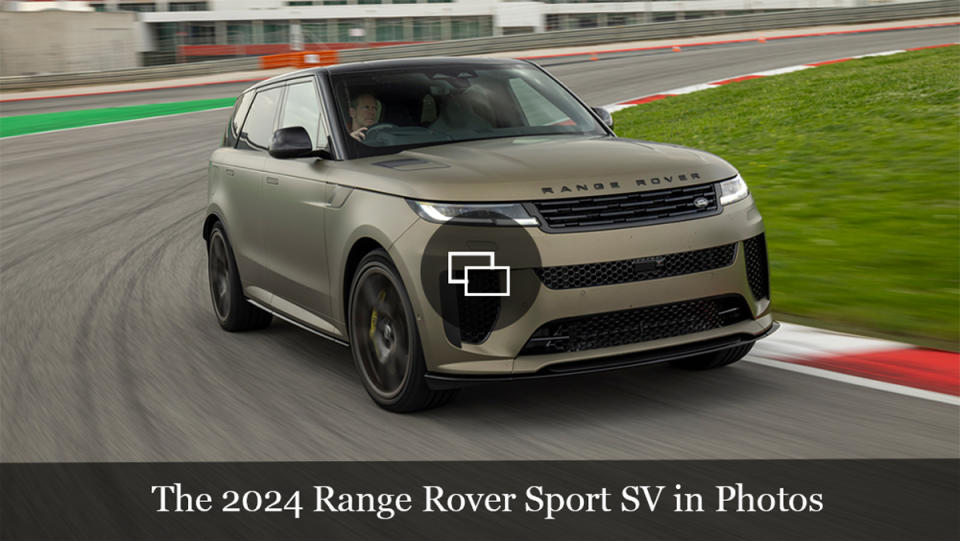First Drive: The New Range Rover Sport SV Is the Fastest, Most Dynamic Model in the Marque’s History
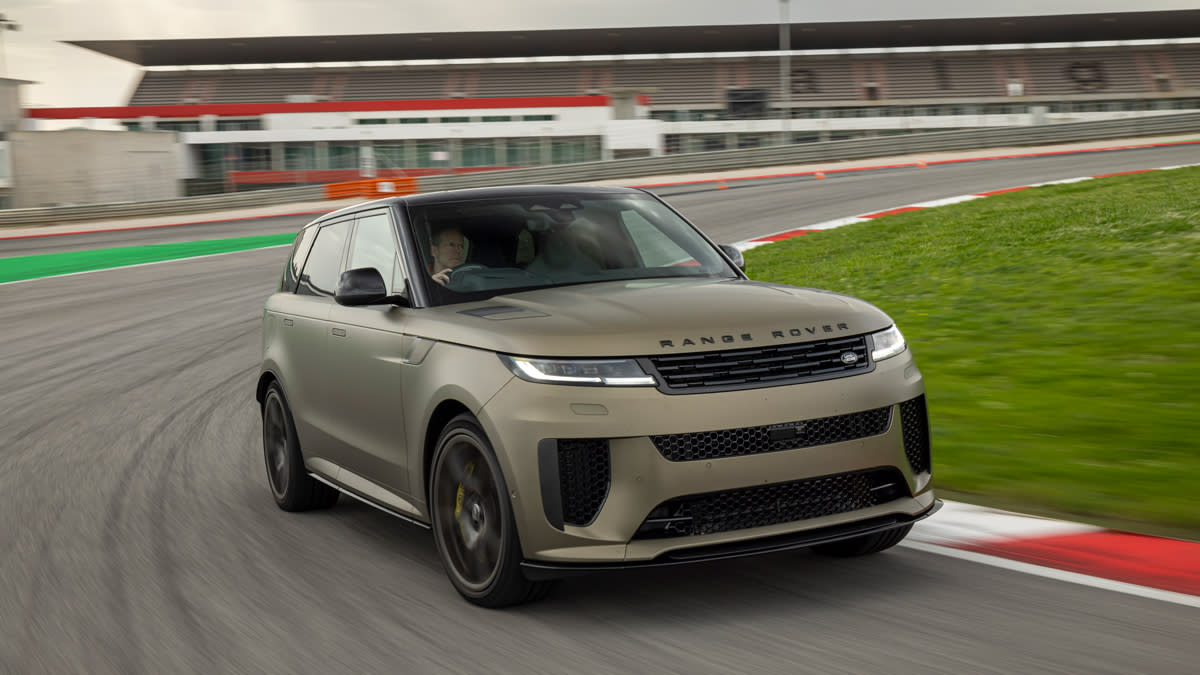
Land Rover just can’t help itself. Facing a pedigreed squad of SUV interlopers —think the UK’s own Rolls-Royce, Bentley, and Aston Martin — the original purveyor of posh British SUVs isn’t about to cede the high-dollar ground. Sprinkle in exotic Italian spice in the Ferrari Purosangue and Lamborghini Urus, and German beef such as the Porsche Cayenne, and the market message is unmistakable: SUVs top the wish list of even the most discriminating buyers, more than sports cars or even traditional sedans.
Enter Land Rover’s Range Rover Sport SV. This 626 hp gloss on the all-new Rover Sport becomes the fastest, most dynamic model in Land Rover’s mud-spattered history. The slant-roofed SV wasn’t only developed to climb tougher off-road obstacles than the competition, but also ascend to market heights as yet unexplored by the Rover Sport.
More from Robb Report
A Yachtmaker Created a Limited-Edition All-White Land Rover Defender, and We Want One
Diamonds Are for... the Road? This New Mercedes G-Wagen Is Laden With Precious Stones
The New Lincoln Aviator SUV Will Now Answer Your Questions While You Drive
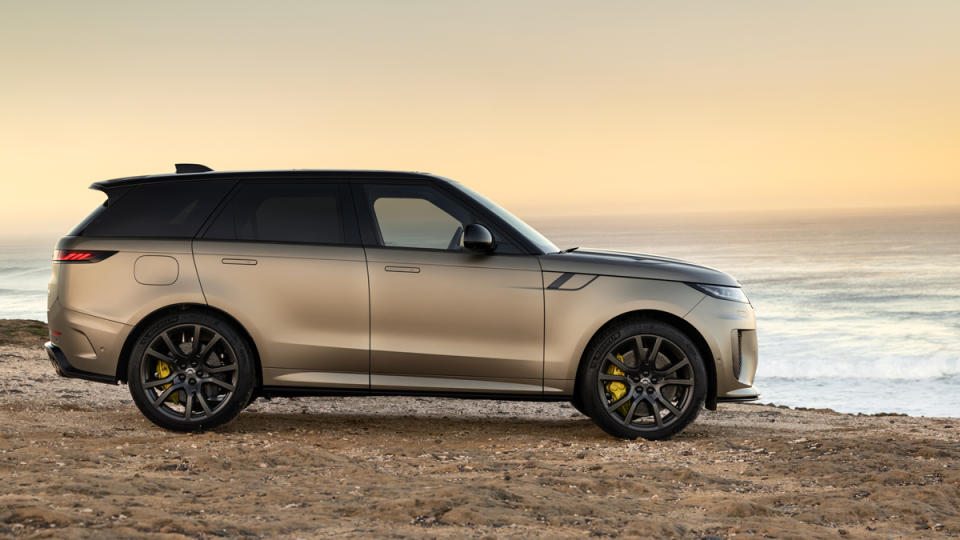
This 2024 “Edition One” model starts from $181,775, and it tops $200,000 with optional carbon-ceramic brakes and dramatic carbon-fiber wheels—standing 23 inches tall—that, together, trim about 45 pounds of unsprung weight at each wheel. Yet the cost of the Sport SV remains less than that of a Bentley Bentayga, Rolls-Royce Cullinan, or Aston Martin DBX707.
My drive along the western spine of Portugal begins at Vermelho, a 13-room boutique hotel designed by Christian Louboutin, who fell in love with the tiny village of Melides and bought a fisherman’s house on the nearby Alentejo coast. Any visitor would swear this villa had stood for centuries, and had been restored for maximal modern charm. In fact, the shoe magnate’s hotel is an entirely new, ground-up design. The Rover Sport SV engages in a similar trompe l’oeil effect, with a shapely form that alludes to a sturdy off-road history, but that largely masks the speed-centric mechanicals below. After a too-brief stay at Vermelho, my luggage-friendly Rover SV is spearing past the vineyards of the scrappy Alentejo wine region, and blurring the bark-regenerating cork oaks that provide stoppers for the world’s wine industry. Next stop, sun-soaked Algarve, the southernmost anchor of Portugal.
Where other 2024 Rover Sports get a turbocharged inline-six engine with hybrid assist, the SV adopts a 4.4-liter V-8, squeezed by twin turbochargers to 626 hp and 553 ft lbs of torque. That V-8 pairs smartly with an eight-speed, paddle-shifted automatic transmission. A selectable active-exhaust system underscores a philosophical change versus the previous Rover Sport SVR.
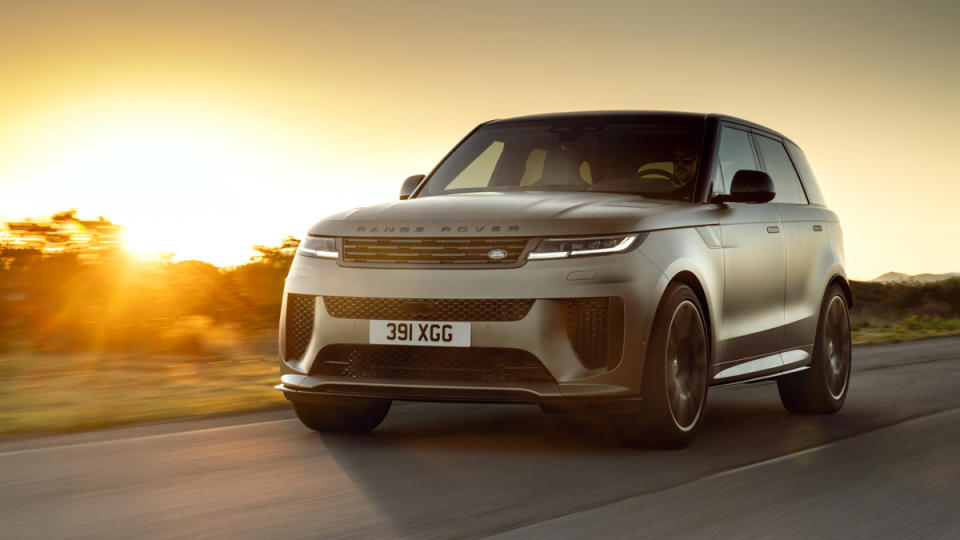
Rover engineers fondly recall that departed model and its supercharged V-8 as “a bit of a sledgehammer.” What I mainly remember (aside from middling handling by Cayenne standards) was that hammer’s effect on passengers’ eardrums. That SVR’s gratuitously rowdy exhaust note was like having the band Motorhead banging away in the back, including belching exhaust backfires at every throttle lift: A diverting experience for about 20 minutes, but soon tiresome in a Range Rover ostensibly aimed at refinement. En route to the Algarve, the Sport SV’s downsized V-8 still snarls when prodded, packs decisively more punch, yet never draws undue attention to itself.
“There’s a bit more finesse to the engineering, yet the bandwidth of the car has gone way up,” says Matt Becker, the former chassis maestro for Lotus and Aston Martin, who brought his talents to Land Rover a few years into the Sport SV’s five-year development.
The Sport SV storms to 60 mph in 3.6 seconds, and keeps churning to 180 mph. More importantly, it raises its dynamic game to roughly Cayenne or BMW X6M levels—if still shy of crossover SUVs such as Ferrari’s Purosangue or Aston’s DBX707 that weigh several hundred pounds less. That zero-to-60 mph burst is more than two seconds faster than the Rover Sport’s 335 hp starter model, and a full second quicker than even the 542 hp Rover Sport PHEV P550e.
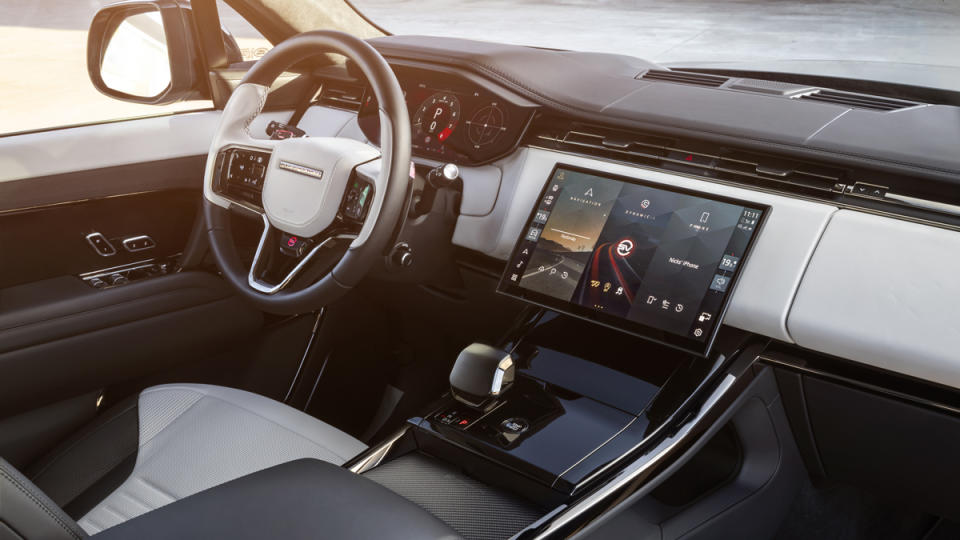
Unleashed on Portugal’s rustic two-lane roads, the Rover is more engaging than a 5,532-pound SUV has any right to feel. Adjustable air springs lower the rakish body by 10 mm to 25 mm versus standard models. And the Rover can tackle serious off-road situations, aided by those height-cranking air springs, a Terrain Response system, and gadgets such as a camera-based wading-depth sensor. I sample all that on an all-terrain course that includes perching the Sport SV on a 29-degree side slope; and steeps that require the (easy) removal of a front aero splitter to avoid scraping the handsome chin.
Back on asphalt, the Rover’s newfound agility flows from another wellspring of tech. The SV steers faster than any Rover before, with a 13.5:1 ratio that’s 30 percent quicker than other Rover Sports. The brand’s first-ever hydraulic suspension links all four corners and their semi-active dampers. Those hydraulic connections eliminate any need for weighty anti-roll bars, and almost magically suppress body roll, pitch, and dive.
A standard rear-steering system can pivot rear wheels at up to 7.3 degrees to trim a turning circle at parking-lot speeds, or help the Rover rotate through fast corners. As speeds climb, rear wheels can turn in phase with fronts to boost stability. Staggered 23-inch tires include thicker 305 mm slabs in the rear to balance that fast-acting front and avoid twitchy reactions. A selectable SV mode biases power toward the rear, and optimizes the throttle, transmission, steering, and rear-steer functions.
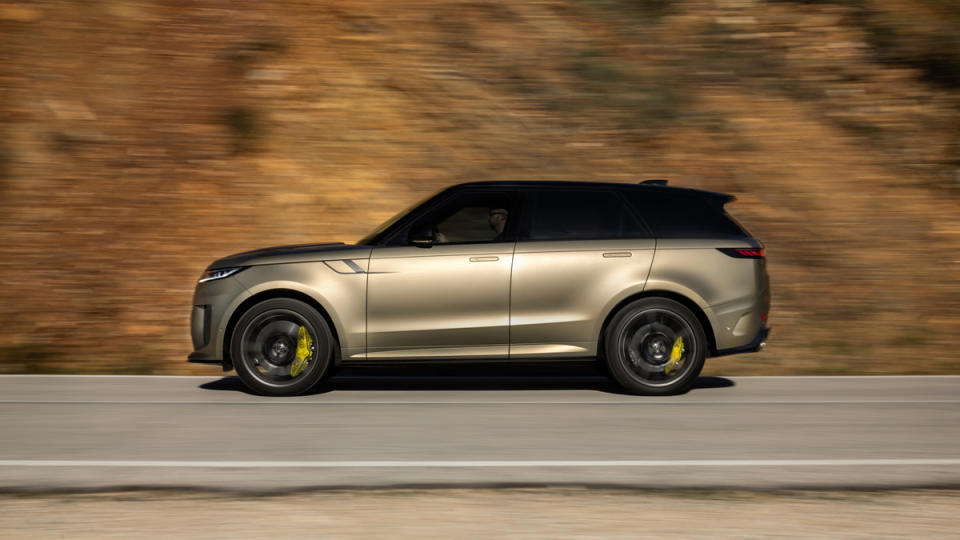
Jamal Hameedi, director of SVO Operations, says the package proved its worth at Germany’s Nürburgring Nordschleife circuit: On that benchmark vehicle-development gauntlet, the Sport SV can knock out eight grueling laps before its tires are shot, versus just two laps for a standard Rover Sport.
After a rip along the Vicentine Coast, I admire this 2.5-ton rabbit at rest. Inside and out, the Sport SV advances the Reductive Design philosophy that Gerry McGovern, Jaguar Land Rover’s chief creative officer, has embraced. The SV adds tasteful jewelry to the Sport’s Botox-smooth skin, in a way that Coco Chanel might approve of. “Range Rover” script is rendered in carbon fiber at the front and rear. White ceramic “SV” roundels are finished by hand. A carbon-fiber hood caps the blunt prow, with enlarged apertures for induction and brake cooling. A reworked rear bumper and diffuser surround four exhaust outlets, wrapped like jumbo burritos with more carbon fiber.
A swank aesthetic, similar to that of a chic London hotel or lounge, defines the interior, where the Rover denudes the cabin of every possible hard switch. Incredibly, there are only two traditional switches, an engine start-stop button and a trunk release hidden near the driver’s knee; three if you count a matte black console shifter for the transmission. The rest springs to life via a 13.1-inch center screen astride the dashboard, and a 13.7-inch driver’s display that dangles from an awning above. The displays are managed by Rover’s Pivi Pro 4 infotainment, including screen-based volume and temperature sliders that are awkward to operate in motion, especially over bumpy ground. That aside, Pivi Pro 4 finds Rover (finally) becoming fully conversant in modern touchscreen interfaces. Like an intriguing first date, there’s a getting-to-know-you period with the infotainment system, but nothing to make you run screaming to the exit.
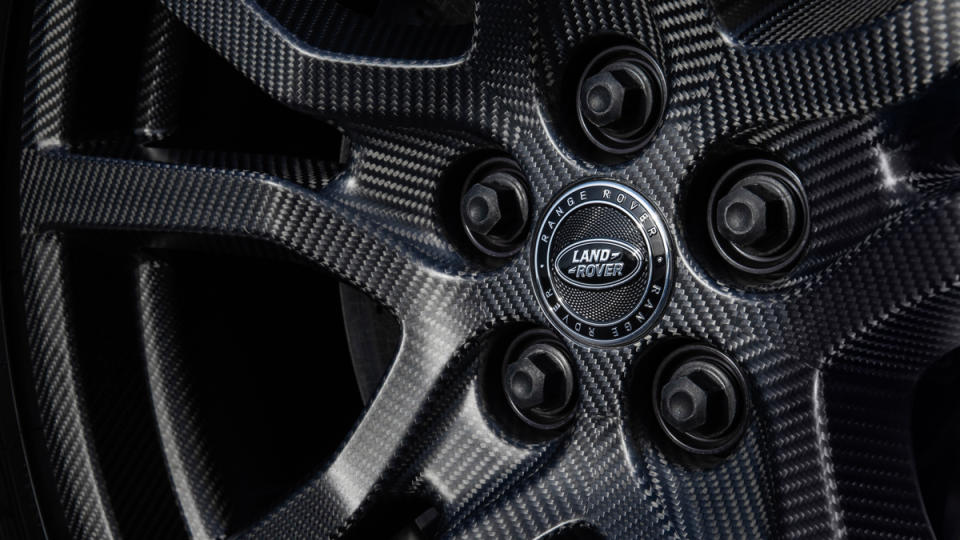
The cabin is fashionably draped in a choice of two-tone Windsor leathers; or animal-free textiles that recall technical fabrics favored by Tom Cruise’s Ethan Hunt, appropriate for the opera house or rugged outback. Another interior gizmo will spark debate. The “Body and Soul Seats” (or “BASS”) function activates four transducers in the front seats. They send energy pulses into front occupants’ torsos, synced to the melodious thrum of a 29-speaker Meridian audio system. Guided by an AI algorithm that analyzes media in real time, those vibrations are limited to musical cues in roughly the 60-to-150 Hertz range. Think basses, kick drums, perhaps the odd oboe. System designers emphasize that this isn’t some newfangled version of a cheap subwoofer in a teenager’s Subaru.
“Anyone can make a bloaty, ‘thump-thump’ noise in a car,” says Duncan Smith, group leader for electronics and interior, citing 24,000 hours of system tuning. “The bit we’re really proud of is the fidelity. We wanted to stay true to the soundstage and what the artist intended. This is an extra immersion in music, an extra layer of communication.”
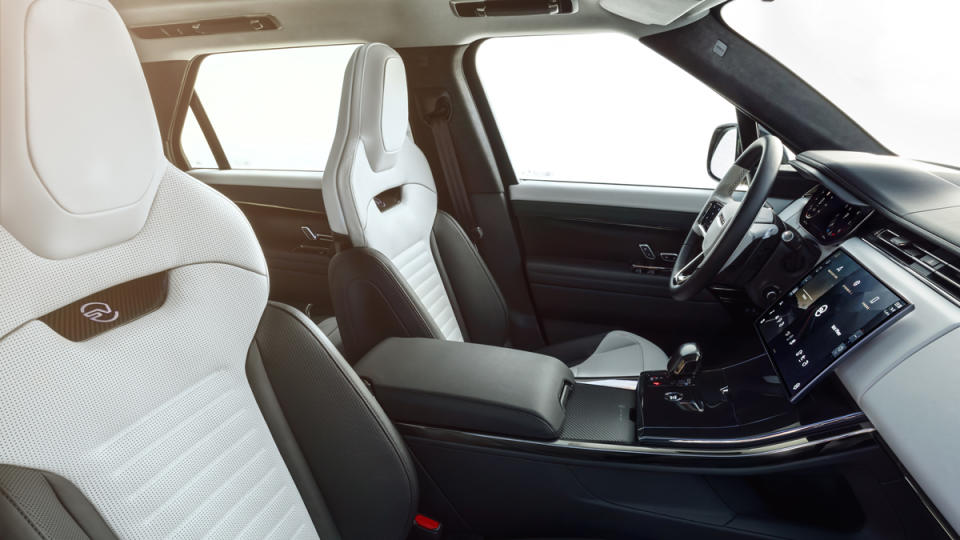
Rover claims that BASS measurably boosts heart-rate variability and skin-contact sensitivity, which correlates to reduced anxiety or improved cognitive response. A series of six “Wellness Tracks,” developed with Coventry University’s National Transport Design Center, are meant to alternatively soothe or engage occupants.
Cueing up Dave Brubeck’s jazz classic “Take Five” as I drive, the sinuous double bass of the late Eugene Wright pulses discreetly into my back. Higher notes strike higher up my spine, and lower notes ping around my kidneys, right in time with the music. The effect gains intensity during a trip through Daft Punk’s bass-heavy electronica. At first, I dismiss BASS as a gimmick, an update of the risible “Sensurround” that made theater seats quiver during 1974’s Earthquake disaster flick. But perhaps Rover is onto something, and other automakers will follow suit.
Sensations are definitely maximized when I pull into the Algarve International Circuit, better known as Portimão, for a lapping session. The Rover is no one’s idea of a track car. But this tailored brute proves surprisingly graceful on one of my favorite European layouts, where Lewis Hamilton posted a pair of Portuguese GP wins during Formula 1’s pandemic run. Even on all-season Michelin Pilot Sport tires, the Rover puts up 1.1 g’s of lateral grip. That rises to1.2 g’s on Michelin Pilot Sport S 5’s, a new summer tire the Sport SV will offer later this year. That’s a level of grip once exclusive to featherweight supercars, now yours in an off-road-capable Range Rover.
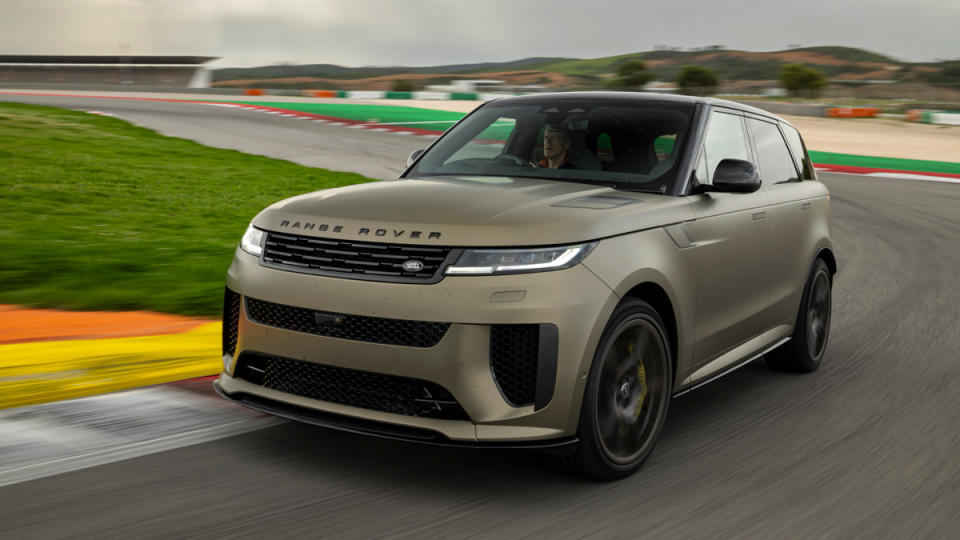
But what really gets me is the brakes, and not just the platter-size rotors that measure 440 mm up front. With traditional brakes, the calipers’ pistons are arranged radially. The bright idea here, hatched by Italy’s Brembo, was to arrange pistons in an “X” shape that concentrates braking forces closer to the center, boosting efficiency. Engineers urged me to mash those brakes at will, insisting they are nearly impervious to fade and overheating. I wasn’t granted enough consecutive laps to test the theory. But where some “performance” SUVs lose stopping power after three or four hot laps, the Rover was braking impressively after six full-bore trips around Portimão.
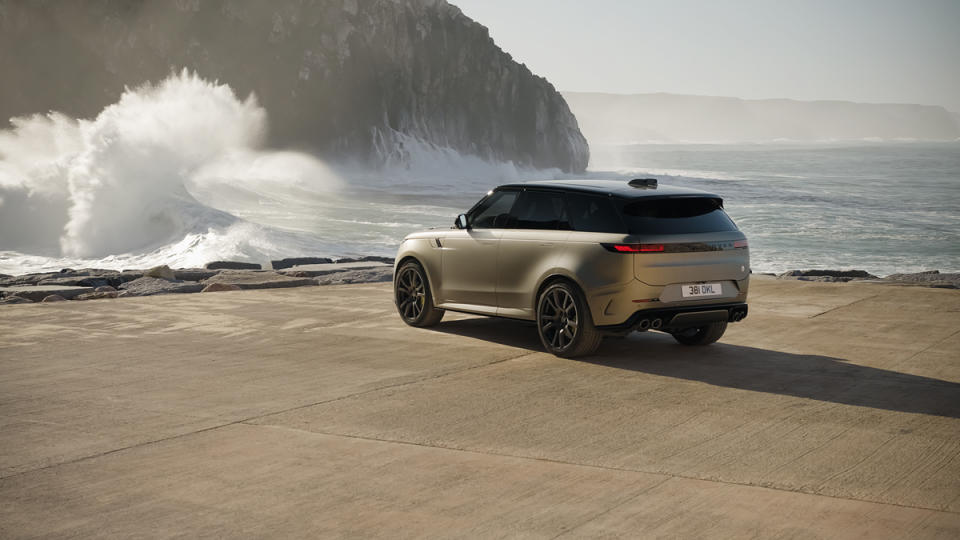
Now, don’t shoot the messenger, but did I mention that you can’t buy a 2024 Range Rover Sport SV? Land Rover gave prospective owners an inside track, allowing them to see and spec the cars in places like Pebble Beach and Dubai. The roughly 600 examples allocated to North America are signed, sealed, and about to be delivered. There will be a 2025 model, though Rover is officially mum on production numbers and timing. It’s the new game in luxury, strangling supply, juicing demand, or justifying big showroom markups on the basis of exclusivity. The latest player just happens to be the raciest of Rovers.
Click here for more photos of the 2024 Range Rover Sport SV.
Best of Robb Report
Sign up for Robb Report's Newsletter. For the latest news, follow us on Facebook, Twitter, and Instagram.
